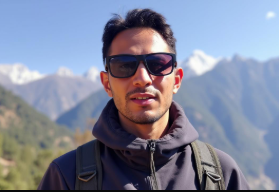Pisang Peak Climbing
Trip Type
Climbing In Nepal
Accomodation
Tea House
Destination
Nepal
Start Point
Kathmandu
Region
Annapurna Region
Duration
15 Days
Pisang Peak is a cone shaped trekking peak that lies between Annapurna I and Manaslu in the Manag district. The Pisang Peak Climbing is quite easy compared to other peaks. This climbing offers the panoramic views of stunning mountains like Annapurna, Chulu range, Manaslu, Himlung, Tilicho peak etc. This peak is suitable for both beginner and experienced climbers. The highest altitude point of this climb is Thorung La Pass(5416 m). You get to visit the sacred Muktinath temple.
Seasonal Information:
The best season to climb Pisang Peak is in the spring and autumn season. In the spring season, the weather is stable and the temperature is also warm. You can witness the blooming rhododendron forest. This season is ideal for climbing because of the clear skies and mild temperature. There is very little snow which makes the climbing conditions ideal. Likewise in the autumn season, the skies are clear. You can see the breathtaking views of the Himalayas. It is quite colder at night. This is the most popular season and quite crowded on the Annapurna circuit.
The other seasons are monsoon and winter. In the monsoon season, heavy rainfall takes places which make the trail slippery and risky. This season is more prone to landslides. Likewise in winter, the weather is extremely cold and harsh. The temperature drops down to -20 degree celsius or even lower at high camo. There is a high risk of storms. It is least recommended to the trekkers and climbers.
Technicality Difficulty of Pisang Peak Climbing
Pisang Peak Climbing demands basic mountaineering skills like using crampons, ice axes, and ropes. You face the rocky terrain at first and slowly transitioning into snow covered ridges. During the ascend time, you may feel altitude sickness so gradual acclimatization is important. It is highly recommended for trekkers who have high altitude experience, basic knowledge of climbing, and good physical fitness.
Preparation Guide:
It is very crucial to be prepared for climbing. Preparation gives higher chances of successful climbing.
-
For Clothing: You need a down jacket, thermal layers, waterproof shell jacket and pants. You need gloves, wool socks, gaiters.
-
For Climbing Gears: You need Crampons and Ice Axe, harness and helmet, carabiners and ropes, mountaineering boots.
-
Other Essentials: Sunglasses, headlamp and batteries, sleeping bags, trekking poles, high energy snacks.
-
For Physical fitness: This trek is suitable for beginners also with many ascents and descents . So you need to be physically fit to walk for long hours.
-
You need Pisang Peak Climbing Permit, Annapurna Conservation Area Permit, TIMS permit.
Sustainability and Responsibility:
The ecosystem of Everest region has been significantly impacted by increasing tourism. Trekkers have some responsibilities towards the environment to preserve the beauty of nature for our own good and for the future generation. Here are some ways to practice environmental responsibility:
-
You can carry garbage bags with you or dispose of trash in designated areas.
-
Avoid using single use plastic water bottles.
-
Choose accommodation that follows sustainable practice.
-
You can purchase local goods to uplift/ support the local economy.
-
Travel in groups to reduce ecological strain.
Accommodation and Food:
Simple tea houses are available along the trail. The tea houses contain beds, pillows, Blankets, common dining area and a shared bathroom. The food that is available include Dal bhat, bread, noodles, momos, tea, eggs, pancakes, pasta, fried rice, porridge etc. LIkewise during base camp, the food is prepared by the trekking crew which includes meals like soup, noodles, rice etc. Energy snacks like bars, nuts, and chocolates are recommended.
🧗♀️ Peak Climbing You Might Like
If you’re looking to take your Himalayan adventure to the next level, these trekking peaks offer the perfect mix of challenge and reward:
Highlights of the Pisang Peak Climbing
-
You can witness the panoramic views of Himalayan peak from summit pisang peak.
-
You’ll trek through one of the most famous and diverse trekking routes of Nepal that is Annapurna Circuit
-
You can explore the culture and tradition of TIbetan-influenced villages, monasteries.
-
You can experience the diverse landscapes from rhododendron forests to rocky ridges.
-
You may spot Himalayan blue sheep, yaks, snow leopard, eagles.
-
You can cross Thorong La Pass
Short Itinerary ( 15 days )
Arrival in Kathmandu and you’ll take a scenic drive through Trishuli and Marshyangdi rivers, terraced farms and villages to reach Dharapani. Distance: 235 km, altitude gain: 1210m
You’ll start your trek to Chame and witness the beautiful scenery along the way. Chame is the entry point of Annapurna Circuit. Distance:150 km, altitude gain: 710 m, walking hours:5-6
You’ll start your trek and pass through pine forest and george. You can witness the views of Manaslu and Annapurna II. Pisang offers the traditional Tibetan culture and stunning views. Distance: 10km, walking hours: 5-6, altitude gain: 630 m
You’ll have a short hike to Ngawal or Ghyaru. You can witness the stunning views of Annapurba and Manaslu Mountains.
You’ll ascend to Pisang Base Camp leaving tree line behind, alpine meadows, yak pastures. Distance: 6km, walking hours: 4-5, altitude gain 1080 m.
You'll steep climb on rocky moraine. You can see the sunset views over Annapurna mountain. Distance: 3km, walking hours: 3-4, altitude gain: 1020m.
You’ll climb over snow and ice. After you reach the top, you can see the 360 degree panoramic views of Annapurna, Manaslu, and Tilicho Peak. Distance: 6-7 km, walking hours: 8-10, altitude gain: 691m, altitude loss: 1711 m.
You’ll return to the Annapurna circuit. You’ll explore the villages of Manang after you reach Manang. Stay overnight at a tea house. Distance: 10 km, walking hours: 5-6, altitude loss: 861 m.
You’ll have a short hike to Yak Kharka. You can enjoy the views of Annapurna II and Gangapurna mountains. Stay overnight at a tea house. Distance: 10km, walking hours: 4-5, altitude gain: 490 m
A short trek to Thorong Phedi which is the last stop before crossing Thorong La Pass. Distance: 6km, walking hours: 3-4, altitude gain: 420m
You’ll cross the Thorong La Pass. After that you’ll trek to Muktinath all the way down. Stay overnight at a tea house in the Muktinath area. Distance: 18km, walking hours: 8-10, altitude loss: 1706 m(from Thorong La Pass)
A short trek to Jomsom and enjoy the apple pies, cider as it is the capital of apples. Distance:12 km, walking hours: 3-4, altitude loss: 1000m
You’ll have a scenic flight to Pokhara. Once you reach Pokhara, you can explore the city. Distance: 160 km, flight time: 20 min, altitude loss 1989 m.
You can either go to Kathmandu by road or by air. Once you reach Kathmandu, you can explore the city, its cultural perspective, and the nightlife of Kathmandu. Distance: 200km(by road), or 25min(by air), driving hours: 6-7, altitude gain: 578 m.
You’ll transfer to the International Airport for your departure concluding the journey.
Cost Includes
-
Cost of permits
-
Professional guide and crew
-
Accommodation and food
-
Transportation
-
Climbing equipment and safety gear
Cost Excludes
-
International and Domestic flight(opting for a Pokhara to Kathmandu flight instead of bus)
-
Travel insurance
-
Your personal trekking and climbing gear
-
Extra accommodation and food
-
Tips for guide


.png)

